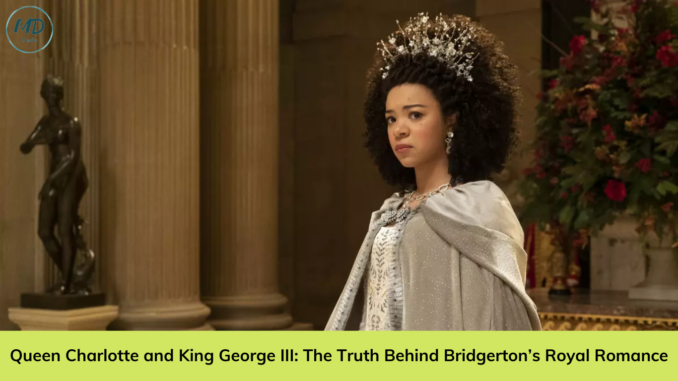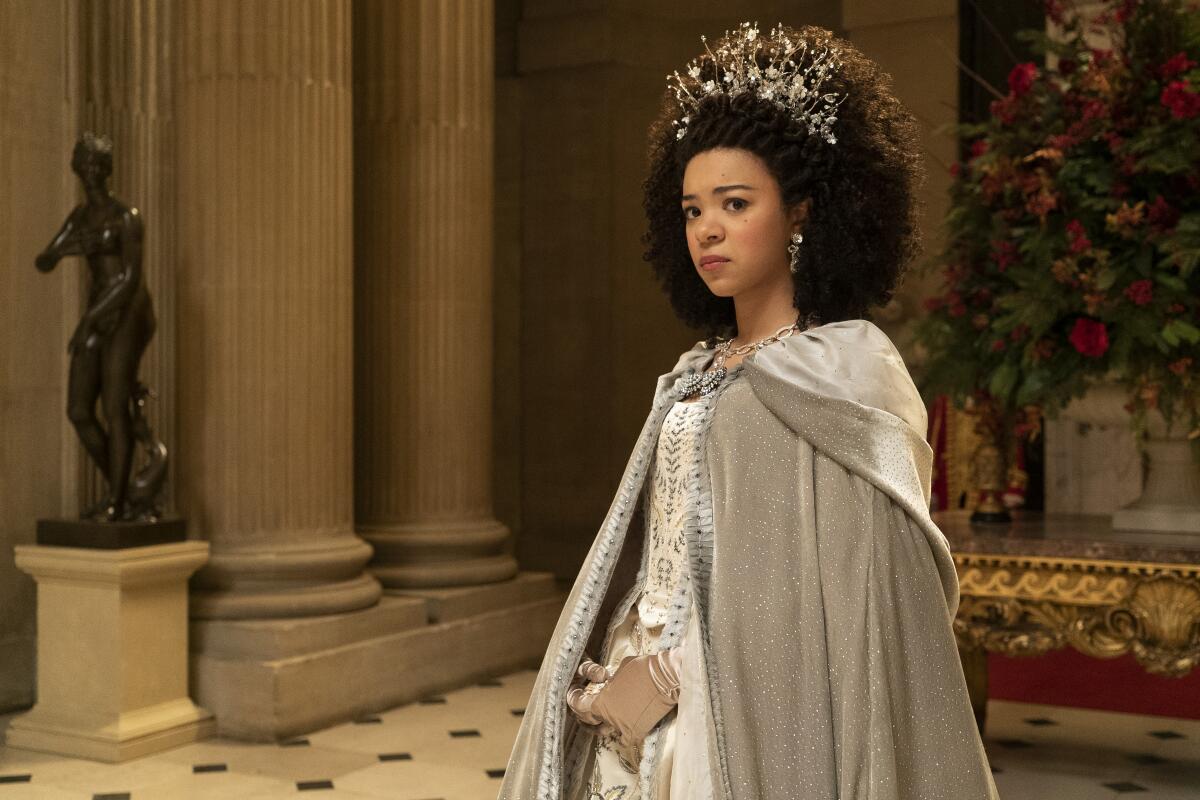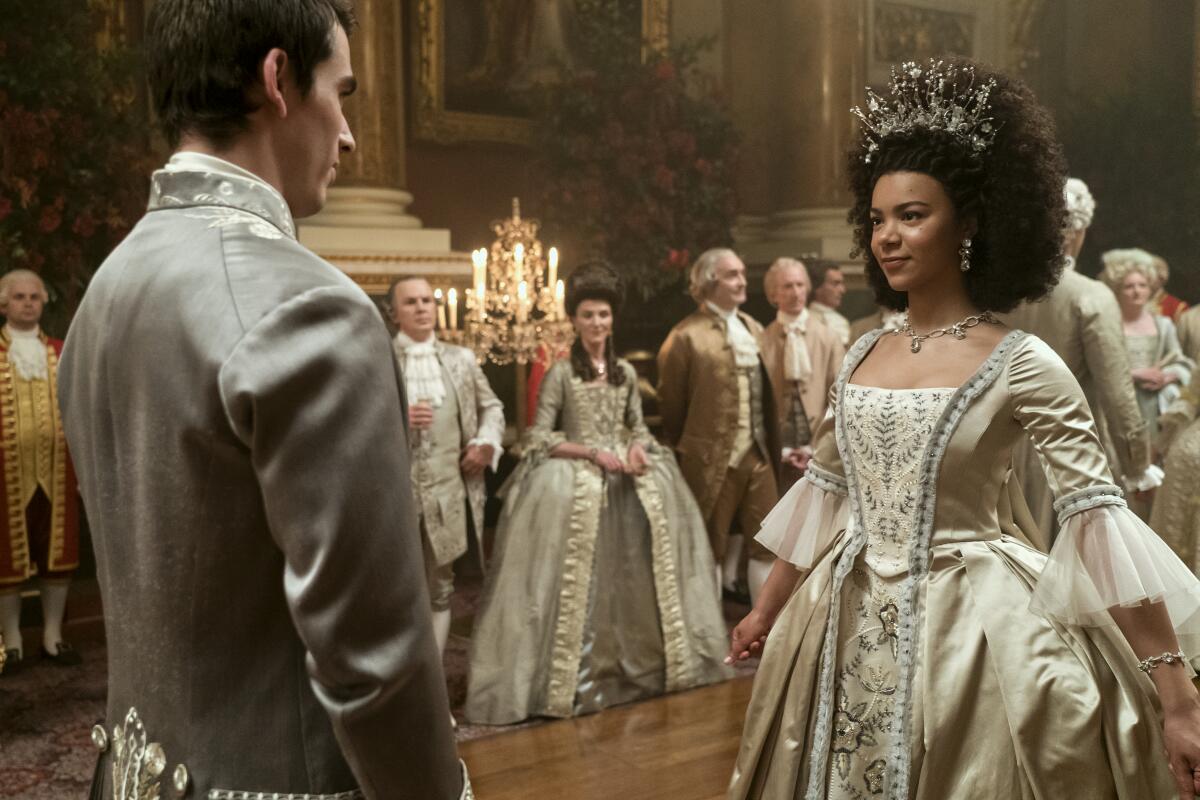
Fans of sexy revisionist romance, rejoice!
“Queen Charlotte: A Bridgerton Story” arrived Thursday on Netflix and offers more of the bodice-ripping and exciting modern twists we’ve come to expect from the “Bridgerton” universe.
Created by Shonda Rhimes, the series cuts between two timelines to explore the life of Queen Charlotte, the monarch who rules over the ton with her enormous wigs and tiny dogs. In the 1760s, Charlotte (India Ria Amarteifio), a 17-year-old princess from an obscure principality in Germany, travels to England and is married hours later to King George III (Corey Mylchreest), arguably the most powerful man in the world. She eventually learns that her aloof new husband is seeking extreme treatment for a mysterious mental illness.
Meanwhile, in the 1810s — the time period portrayed in “Bridgerton” — an older Charlotte (Golda Rosheuvel, reprising her role from “Bridgerton”) is living apart from her husband, whose mental health has long been in decline. Following the death of her granddaughter in childbirth, Charlotte finds herself increasingly frustrated by her wayward adult children, who have failed to produce enough legitimate heirs to secure the royal line of succession.
The series takes a humanizing look at the diva-like Charlotte, the dramatic circumstances she faced at such a young age and the painful trajectory of her once-happy marriage. It also portrays George as a well-meaning, curious and vulnerable young man afflicted with a poorly understood disease that affected his mental health — a contrast to the caricature of a mad tyrant that Americans are accustomed to from high school history lessons and pop culture like “Hamilton.”
While “Queen Charlotte” is a conscious work of historical revision that takes clear artistic license, many details about the characters and the world they lived in are drawn from fact.
We spoke to three experts to get a fuller picture of the life and times of George and Charlotte: Janice Hadlow, author of “A Royal Experiment: The Private Life of King George III”; Andrew Roberts, author of “The Last King of America: The Misunderstood Reign of King George III”; and Catherine Curzon, author of “The Real Queen Charlotte: Inside the Real Bridgerton Court.”
Charlotte was plucked from relative obscurity to marry the king
“George came to the throne in 1760 with big ideas about the kind of king he hoped to be,” said Hadlow. He was just 22 when he became king, and “interrogated himself constantly about the purpose of monarchy in the modern world.” Eventually, he decided the job of a king was “to become the moral compass of the country, the conscience of the nation and an example to all his subjects, high and low,” she said.
This meant his private life had to reflect his moral authority and that he would need to “leave behind him the spectacular dysfunctional horrors that blighted the lives of his Hanoverian predecessors,” Hadlow said. George knew it would be impossible to achieve his goals without the perfect wife by his side, so his search was extensive.
“Because of the political and geostrategic exigencies of the day, they needed to have a Protestant princess” who was of childbearing age, said Roberts. “And so that wiped out huge areas of the world apart from Germany and Scandinavia.” Many candidates were eliminated because they were “free thinkers” — atheists or agnostics — or, ironically, because they had “lunacy” in the family.
George was less concerned about beauty than character. “He hoped for a woman of good understanding, but not an intellectual. She should have no taste for politics or argument. A sweet, mild disposition was essential, as was a deep religious faith,” Hadlow said.
Surprising just about everyone, George eventually chose Princess Charlotte of Mecklenburg-Strelitz, a small principality comparable in size to an English county. “Her name had only been added as an afterthought to those of richer, better-connected princesses, but George liked what he heard of her,” Hadlow said. “She was well-educated, quietly brought up, shy, modest and an accomplished player on the glockenspiel.” How could any man resist?

According to one theory, Charlotte may have had African heritage
“Bridgerton” is a revisionist Regency romance that consciously makes space for more diverse characters in a genre that has been overwhelmingly white. “Queen Charlotte” shows how the racially integrated world of “Bridgerton” came to be — through a mixed-race royal marriage and the extension of titles to Black aristocracy.
While Charlotte’s real-life tenure didn’t permanently alter the demographic makeup of the British aristocracy as it does in this series, the idea that Charlotte may have had African ancestry is not without precedent. According to a theory first presented by a historian named Mario de Valdes y Cocom, Charlotte was a direct descendant of a branch of the Portuguese royal family with Black ancestry. As further evidence, he cited contemporary accounts of features that were “conspicuously African.” The theory has led some people to embrace Charlotte as “Britain’s first Black queen” and was often mentioned in discussions about Meghan, the Duchess of Sussex, and her groundbreaking role as a biracial royal.
“It’s not impossible that Queen Charlotte may have had Black ancestors,” said Hadlow, noting how many people have diverse ancestry that they’ve only discovered through DNA testing. “This is perhaps even more likely to be the case for royal and princely families with a tradition of marrying into distant dynasties with complex histories of their own,” she added.
Charlotte married George hours after arriving in England
The marriage ceremony did in fact take place the night Charlotte reached London, and her journey there was, if anything, more harrowing than what we see in “Queen Charlotte.” She faced “a terrible sea-crossing beset by gales, during which everyone was seasick except the young queen-to-be, who apparently played the harpsichord to cheer up her companions,” said Hadlow.
After the ceremony, the couple retired to bed, unaccompanied by guests, as Charlotte had requested. “The King agreed, and they began their life together with a private intimacy none of their predecessors had enjoyed,” Hadlow said.
Charlotte was also an orphan who didn’t speak English until she became queen. On her way to England, she practiced saying “‘God save the king,’ in English,” said Roberts. Though she picked up the language quickly, she spoke with a German accent her whole life.
Curzon compares the young queen to a more recent royal, Princess Diana, in that she was both quite sheltered and young but also quite self-possessed and engaging. En route to London, she was greeted by well-wishers and curiosity seekers who wanted to see their new queen.
Unlike other royal marriages, their union was happy for many years
Charlotte and George had a model marriage for many years, even sharing a bedroom — unusual for royal couples of the time. They had 15 children together, and George never took a mistress — the only Hanoverian king not to do so. “It’s a tremendously dystopian dynasty — they all tend to hate their fathers and hate their sons,” said Roberts. (George’s own father died when he was 12, and he despised his grandfather, who was physically abusive.)
“Charlotte was never obliged to turn a blind eye to her husband’s intrigues, forced to receive the current lover as her lady-in-waiting, or humiliated in public by her husband’s obvious preference for another lady. Many of her royal contemporaries would have envied her situation,” said Hadlow.
The couple enjoyed a relatively quiet lifestyle and shared interests such as books and music, even bringing Mozart to England, as seen in “Queen Charlotte.”
But the marriage had its challenges, even before George became ill. George allowed his wife to cultivate few close friendships, for fear of favoritism. Charlotte “was often isolated and lonely and found the rituals of royal life weighed increasingly heavily upon her,” said Hadlow. “There was little opportunity for spontaneity or excitement.” Then there was the fact that she spent nearly two decades continuously pregnant, giving birth to 15 children between 1762 and 1783.
Still, Charlotte beat the grim odds faced by most women of the era simply by surviving childbirth unscathed and seeing most of her children live to adulthood. Curzon cited a letter written to a newspaper after the death of one of Charlotte’s children that said she could now call herself a mother. “You’d not been through parenthood in that era, unless one of your children had died,” she said.

George most likely suffered from bipolar disorder
There have been a number of theories about what caused George’s mental illness. For many years, it was believed the king suffered from acute porphyria, a genetic disorder that can affect the nervous system. But this theory, first introduced in the 1960s and popularized in the play “The Madness of George III,” has been called into question by more recent research and a growing understanding of psychological illness. Experts now believe it likely that George, who was known for his “incessant loquacity,” had bipolar disorder, and experienced four or more acute bouts of the disease throughout his life. In his final years, as portrayed in “Bridgerton” and “Queen Charlotte,” he was also afflicted with blindness and dementia, though he ultimately lived to be 81 — quite old for the time.
Treatments for mental illness were more like torture
In “Queen Charlotte,” young George is treated by a ghoulish physician named John Monro, who subjects him to brutal treatments. Monro was a real historical figure who was consulted about George’s health and ran the Bethlem Royal Hospital, a notorious asylum nicknamed “Bedlam” because of its harrowing conditions. Monro came from a family dynasty of so-called “mad doctors” who used barbaric methods to treat mentally ill patients, and was even known to charge curiosity seekers admission to Bethlem, where they gawked at the patients.
George was subjected to horrific treatments like the ones we see in “Queen Charlotte.” “He was tortured, essentially,” said Roberts, rattling off the treatments, which included leeches, bloodletting, blistering the skin and tying him up in a straitjacket for days on end. “That was what you did with mentally ill people in those days, and it was exactly the worst thing to do.” Unfortunately, there was plenty of incentive for crank physicians to keep George sick, Roberts said. “They were being paid three times the amounts that you got for a normal consultation fee.”
Eventually, another physician named Francis Willis got involved in the king’s care and was known for taking a more modern approach to treatment that provided temporary relief, according to Roberts.
